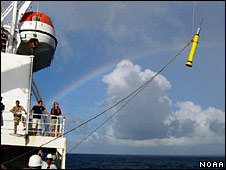Gulf Stream ‘Is Not Slowing Down’

The Gulf Stream does not appear to be slowing down, say US scientists who have used satellites to monitor tell-tale changes in the height of the sea.
(From BBC News / By Richard Black) — Confirming work by other scientists using different methodologies, they found dramatic short-term variability but no longer-term trend.
A slow-down – dramatised in the movie The Day After Tomorrow – is projected by some models of climate change.
The research is published in the journal Geophysical Research Letters.
The stream is a key process in the climate of western Europe, bringing heat northwards from the tropics and keeping countries such as the UK 4-6C warmer than they would otherwise be.
It forms part of a larger movement of water, the Atlantic Meridional Overturning Circulation, which is itself one component of the global thermohaline system of currents.
Between 2002 and 2009, the team says, there was no trend discernible – just a lot of variability on short timescales.
“The Atlantic overturning circulation is still an important player in today’s climate” – Josh Willis, Nasa
The satellite record going back to 1993 did suggest a small increase in flow, although the researchers cannot be sure it is significant.
“The changes we’re seeing in overturning strength are probably part of a natural cycle,” said Josh Willis from Nasa’s Jet Propulsion Laboratory (JPL) in California.
“The slight increase in overturning since 1993 coincides with a decades-long natural pattern of Atlantic heating and cooling.”
Short measures
The first observations suggesting the circulation was slowing down emerged in 2005, in research from the UK’s National Oceanography Centre (NOC).
Using an array of detectors across the Atlantic and comparing its readings against historical records, scientists suggested the volume of cold water returning southwards could have fallen by as much as 30% in half a century – a significant decline.
The warm surface water sinks in the Arctic and flows back southwards at the bottom of the ocean, driving the circulation.
However, later observations by the same team showed that the strength of the flow varied hugely on short timescales – from one season to the next, or even shorter.
But they have not found any clear trend since 2004.

Rapid relief
The NOC team now has a chain of instruments in place across the Atlantic, making measurements continuously.
“In four-and-a-half years of measurement, we have found there is a lot of variability, and we’re working to explain it,” said NOC’s Harry Bryden.
The quantities of water involved are huge, varying between four million and 35 million tonnes of water per second.
The array is part of the UK-funded Rapid project, which aims to refine understanding of potentially large climate change impacts that could happen in short periods.
Professor Bryden’s team calculates that their system is good enough to detect a long-term change in flow of about 20% – but it has not happened yet.
He believes the JPL approach – using satellite altimeters, instruments that can measure sea height precisely, and the Argo array of autonomous floating probes – could potentially add useful data to that coming from long-term on-site monitoring arrays.
But, he points out: “The method concentrates only on the upper [northward] flow – it doesn’t give you much information on the returning flow southward.”
Fantasy and reality
Driven by Hollywood, a popular image of a Gulf Stream slowdown shows a sudden catastrophic event driving snowstorms across the temperate lands of western Europe and eastern North America.
That has always been fantasy – as, said Josh Willis, is the idea that a slow-down would trigger another ice age.
“But the Atlantic overturning circulation is still an important player in today’s climate,” he added.
“Some have suggested cyclic changes in the overturning may be warming and cooling the whole North Atlantic over the course of several decades and affecting rainfall patterns across the US and Africa, and even the number of hurricanes in the Atlantic.”


